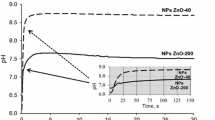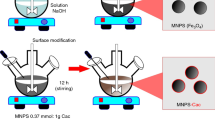Abstract
Wet methods for nanoparticle characterization need to use the surfactants to prevent the agglomeration of particles in hydrosols. In this work, we investigated the effect of pH on the agglomeration state and the stability of differently sized Fe2O3 nanoparticles, notably 35 and 120 nm in average, in amino acid solutions as glycine, l-lysine and l-glutamine, using the method of dynamic light scattering. The lowest electrokinetic stability and maximum agglomeration of both hydrosols was found in the acidic medium, particularly, at pH = 3.5 for Fe2O3-35 and pH = 6.5 for Fe2O3-120 (surface isoelectric point). At pH ≤ 7 in amino acid–based solutions, the charge direction was depended on the particles size. The pH growth from 5 to 9 suppressed Fe2O3 particle agglomeration although the effect of pH was much higher in glycine (neutral amino acid) where the agglomerates’ size decreased by 4.5 times compared with 2.8 in glutamine (acidic amino acid) and 1.8 in lysine (basic amino acid). It was concluded that the pH predominantly affected an agglomeration with respect to the particle size and acidity of amino acids. In alkali medium at pH = 9, particles had a maximum charge and minimum size in all solutions. For example, in glycine, the average size/zeta potential of Fe2O3-35 and Fe2O3-120 agglomerates were, respectively, 180 ± 20 nm/− 32 mV and 263 ± 80 nm/− 38 mV compared with water 510 ± 20 nm/− 18 mV and 180 ± 69 nm/− 24 mV.







Similar content being viewed by others
References
Bao Y, Wen T, Samia ACS, Khandhar A, Krishnan KM (2015) Magnetic nanoparticles: material engineering and emerging applications in lithography and biomedicine. J Mater Sci 51(1):513–553. https://doi.org/10.1007/s10853-015-9324-2
Bhattacharya D, Sahu S, Banerjee I, Das M, Mishr D, Maiti TK, Pramanik P (2011) Synthesis, characterization, and in vitro biological evaluation of highly stable diversely functionalized superparamagnetic iron oxide nanoparticles. J Nanopart Res 13:4173–4188. https://doi.org/10.1007/s11051-011-0362-7
Biju CS, Raja DH, Padiyan DP (2014) Glycine assisted hydrothermal synthesis of α-Fe2O3 nanoparticles and its size dependent properties. Chem Phys Lett 610-611:103–107. https://doi.org/10.1016/j.cplett.2014.07.024
Cabrera D, Camarero J, Ortega D, Teran FJ (2015) Influence of the aggregation, concentration, and viscosity on the nanomagnetism of iron oxide nanoparticle colloids for magnetic hyperthermia. J Nanopart Res 17(121). https://doi.org/10.1007/s11051-015-2921-9
Cao H, Wang G, Warner JH, Watt AAR (2008) Amino-acid-assisted synthesis and size-dependent magnetic behaviors of hematite nanocubes. Appl Phys Lett 92:013110. https://doi.org/10.1063/1.2830699
Chaudhari NK, Kim M, Bae T, Yu J (2013) Hematite (α-Fe2O3) nanoparticles on vulcan carbon as an ultrahigh capacity anode material in lithium ion battery. Electrochim Acta 114:60–67. https://doi.org/10.1016/j.electacta.2013.09.169
De Sousa ME, Fernández van Raap MB, Rivas PC, Mendoza Zélis P, Girardin P, Pasquevich GA, Alessandrini JL, Muraca D, Sánchez FH (2013) Stability and relaxation mechanisms of citric acid coated magnetite nanoparticles for magnetic hyperthermia. J Phys Chem 117:5436–5445. https://doi.org/10.1021/jp311556b
Demangeat E, Pedrot M, Dia A, Bouhnik-le-Coz M, Grasset F, Hanna K, Kamagatec M, Cabello-Hurtado F (2018) Colloidal and chemical stabilities of iron oxide nanoparticles in aqueous solutions: the interplay of structural, chemical and environmental drivers. Environ Sci Nano 5:992–1001. https://doi.org/10.1039/C7EN01159H
Doyen M, Goole J, Bartik K, Bruylants G (2016) Amino acid induced fractal aggregation of gold nanoparticles: why and how. J Colloid Interface Sci 464:160–166. https://doi.org/10.1016/j.jcis.2015.11.017
Farre M, Gajda-Schrantz K, Kantiani L, Barcelo D (2009) Ecotoxicity and analysis of nanomaterials in the aquatic environment. Anal Bioanal Chem 393:81–95. https://doi.org/10.1007/s00216-008-2458-1
Favela-Camacho SE, Samaniego-Benitez EJ, Godinez-Garcia A, Aviles-Arellano LM, Perez-Robles JF (2019) How to decrease the agglomeration of magnetite nanoparticles and increase their stability using surface properties. Colloid Surface A 574:29–35. https://doi.org/10.1016/j.colsurfa.2019.04.016
Gao J, Wei W, Shi M, Han H, Lu J, Xie J (2016) A controlled solvethermal approach to synthesize nanocrystalline iron oxide for Congo red adsorptive removal from aqueous solutions. J Mater Sci 51:4481–4494. https://doi.org/10.1007/s10853-016-9760-7
Holbrook RD, Galyean AA, Gorham JM, Herzing A, Pettibone J (2015) Overview of nanomaterial characterization and metrology. Frontiers of Nanoscience 8:47–87. https://doi.org/10.1016/b978-0-08-099948-7.00002-6
Ingram DR, Kotsmar C, Yoon KY, Shao S, Huh C, Bryant SL, Milner TE, Johnston KP (2010) Superparamagnetic nanoclusters coated with oleic acid bilayers for stabilization of emulsions of water and oil at low concentration. J Colloid Interface Sci 351:225–232. https://doi.org/10.1016/j.jcis.2010.06.048
ISO 13099-2:2012, Colloidal system. Methods for zeta potential determination. Part 2: Optical methods, June 2012
Jiang J, Oberdörster G, Biswas P (2009) Characterization of size, surface charge, and agglomeration state of nanoparticle dispersions for toxicological studies. J Nanopart Res 11(1):77–89. https://doi.org/10.1007/s11051-008-9446-4
Kandori K, Sakai M, Inoue S, Ishikawa T (2006) Effects of amino acids on the formation of hematite particles in a forced hydrolysis reaction. J Colloid Interface Sci 293:108–115. https://doi.org/10.1016/j.jcis.2005.06.029
Kast CE, Schnurch AB (2001) Thiolated polymers-thiomers: development, in vitro evaluation of chitosan-thioglycolic acid conjugates. Biomaterials 22:2345–2352. https://doi.org/10.1016/s0142-9612(00)00421-x
Li J, Wang S, Shi X, Shen M (2017) Aqueous-phase synthesis of iron oxide nanoparticles and composites for cancer diagnosis and therapy. Adv Colloid Interf Sci 249:374–385. https://doi.org/10.1016/j.cis.2017.02.009
Li W, Liu D, Wu J, Kim C, Fortner JD (2014) Aqueous aggregation and surface deposition processes of engineered superparamagnetic iron oxide nanoparticles for environmental applications. Environ Sci Technol 48:11892–11900. https://doi.org/10.1021/es502174p
Lin C-L, Lee C-F, Chiu W-Y (2005) Preparation and properties of poly(acrylic acid) oligomer stabilized superparamagnetic ferrofluid. J Colloid Interface Sci 291:411–420. https://doi.org/10.1016/j.jcis.2005.05.023
Lin D, Cai P, Peacock CL, Wu Y, Gao C, Peng W, Huang Q, Liang W (2018) Towards a better understanding of the aggregation mechanisms of iron (hydr)oxide nanoparticles interacting with extracellular polymeric substances: role of pH and electrolyte solution. Sci Total Environ 645:372–379. https://doi.org/10.1016/j.scitotenv.2018.07.136
Liu JF, Zhao ZS, Jiang GB (2008) Coating Fe3O4 magnetic nanoparticles with humic acid for high efficient removal of heavy metals in water. Environ Sci Technol 42:6949–6954. https://doi.org/10.1021/es800924c
Lucas IT, Durand-Vidal S, Dubois E, Chevalet J, Turq P (2007) Surface charge density of maghemite nanoparticles: role of electrostatics in the proton exchange. J Phys Chem C 111:18568–18576. https://doi.org/10.1021/jp0743119
Majewski P, Thierry B (2007) Functionalized magnetite nanoparticles – synthesis, properties, and bio-applications. Crit Rev Solid State 32(3–4):203–215. https://doi.org/10.1080/10408430701776680
Mohammed L, Gomaa HG, Ragab D and Zhu J (2017) Magnetic nanoparticles for environmental and biomedical applications: a review. Particuology 30:1–1. 10.1016/j.partic.2016.06.001, 14
Mohapatra S, Pramanik N, Mukherjee S, Ghosh SK, Pramanik P (2007) A simple synthesis of amine-derivatised superparamagnetic iron oxide nanoparticles for bioapplications. J Mater Sci 42:7566–7574. https://doi.org/10.1007/s10853-007-1597-7
Morgan LJ, Ananthapadmanabhan K, Somasundaran P (1986) Oleate adsorption on hematite: problems and methods. Int J Miner Process 18:139–152. https://doi.org/10.1016/0301-7516(86)90012-8
Nagajyothi PC, Pandurangan M, Kim DH, Sreekanth TVM, Shim J (2017) Green synthesis of Iron oxide nanoparticles and their catalytic and in vitro anticancer activities. J Clust Sci 28:245–257. https://doi.org/10.1007/s10876-016-1082-z
Parida P, Lolage M, Angal A, Rautaray D (2017) Iron oxide nanoparticles to remove arsenic from water. Nanoscience in Food and Agriculture 4:279–299. https://doi.org/10.1007/978-3-319-53112-0_10
Palchetti S, Pozzi D, Mahmoudi M, Caracciolo G (2016) Exploitation of nanoparticle–protein corona for emerging therapeutic and diagnostic applications. J Mater Chem B 4(25):4376–4381. https://doi.org/10.1039/c6tb01095d
Patel VR, Agrawal YK (2011) Nanosuspension: an approach to enhance solubility of drugs. J Adv Pharm Technol Res 2:81–87. https://doi.org/10.4103/2231-4040.82950
Ramos AP (2017) Dynamic light scattering applied to nanoparticle characterization. In: Alessandra L (ed) Nanocharacterization techniques, Elsiver, pp 99–110
Rasmussen K, Rauscher H, Mech A et al (2018) Physico-chemical properties of manufactured nanomaterials - characterisation and relevant methods. An outlook based on the OECD testing programme. Regul Toxicol Pharmacol 92:8–28. https://doi.org/10.1016/j.yrtph.2017.10.019
Ren X, Chen H, Yang V, Sun D (2014) Iron oxide nanoparticle-based theranostics for cancer imaging and therapy. Front Chem Sci Eng 8(3):253–264. https://doi.org/10.1007/s11705-014-1425-y
Schnurch AB, Hornof M, Guggi D (2004) Thiolated chitosans. Eur J Pharmacol Biopharm 57:9–17. https://doi.org/10.1016/s0939-6411(03)00147-4
Shen W-Z, Cetinel S, Sharma K, Borujeny ER, Montemagno C (2017) Peptide-functionalized iron oxide magnetic nanoparticle for gold mining. J Nanopart Res 19:74. https://doi.org/10.1007/s11051-017-3752-7
Svetlichnyi VA, Shabalina AV, Lapin IN, Goncharova DA, Velikanov DA, Sokolov AE (2018) Study of iron oxide magnetic nanoparticles obtained via pulsed laser ablation of iron in air. Appl Surf Sci 462:226–236. https://doi.org/10.1016/j.apsusc.2018.08.116
Talbot D, Abramson S, Griffete N, Bée A (2018) pH-sensitive magnetic alginate/γ-Fe2O3 nanoparticles for adsorption/desorption of a cationic dye from water. Journal of Water Process Engineering 25:301–308. https://doi.org/10.1016/j.jwpe.2018.08.013
Tartaj P, del Puerto Morales M, Veintemillas-Verdaguer S, Gonz lez-Carre T, Serna CJ (2003) The preparation of magnetic nanoparticles for applications in biomedicine. J Phys D: Appl Phy 36(13):R182–R197. https://doi.org/10.1088/0022-3727/36/13/202
Teja AS, Holm LJ (2002) Supercritical fluid technology in materials science and engineering: synthesis, properties, and applications. Elsevier, pp 327–349
Teja AS, Koh P-Y (2009) Synthesis, properties, and applications of magnetic iron oxide nanoparticles. Prog Cryst Growth & Charact 55:22–45. https://doi.org/10.1016/j.pcrysgrow.2008.08.003
Ustunol IB, Gonzalez-Pech NI, Grassian VH (2019) pH-dependent adsorption of α-amino acids, lysine, glutamic acid, serine and glycine, on TiO2 nanoparticle surfaces. J Colloid Interf Sci accepted 554:362–375. https://doi.org/10.1016/j.jcis.2019.06.086
Wang GH, Li WC, Jia K, Lu AH, Feyen M, Spliethoff B, Schüth F (2011) A facile synthesis of shape- and size-controlled α-Fe2O3 nanoparticles through hydrothermal method. Nano 5:469–479. https://doi.org/10.1142/s1793292011002846
Wu D, Liu P, Wang T, Chen X, Yang L, Jia D (2018) Amino acid-assisted synthesis of Fe2O3/nitrogen doped graphene hydrogels as high performance electrode material. Electrochim Acta 283:1858–1870. https://doi.org/10.1016/j.electacta.2018.07.103
Xu XQ, Shen H, Xu JR, Xie MQ, Li XJ (2006) The colloidal stability and core-shell structure of magnetite nanoparticles coated with alginate. Appl Surf Sci 253:2158–2164. https://doi.org/10.1016/j.apsusc.2006.04.015
Acknowledgments
X-ray analysis was carried out in the framework of Tomsk Polytechnic University Competitiveness Enhancement Program, Russia. Synthesis of Fe2O3-35 particles was carried out in the framework of Tomsk State University Competitiveness Enhancement Program.
Funding
The work was supported by the Ministry of Science and Education of the Russian Federation, Russian Fund for Basic Research (project # 15-03-06528_а), and in the framework of Increase Competitiveness Program of NUST “MISiS.”
Author information
Authors and Affiliations
Corresponding author
Ethics declarations
Conflict of interest
The authors declare that they have no conflict of interest.
Additional information
Publisher’s note
Springer Nature remains neutral with regard to jurisdictional claims in published maps and institutional affiliations.
Rights and permissions
About this article
Cite this article
Godymchuk, A., Papina, I., Karepina, E. et al. Agglomeration of iron oxide nanoparticles: pH effect is stronger than amino acid acidity. J Nanopart Res 21, 208 (2019). https://doi.org/10.1007/s11051-019-4634-y
Received:
Accepted:
Published:
DOI: https://doi.org/10.1007/s11051-019-4634-y




